



Feed granulometry and the importance of feed particle size in layers
Differences in particle size within a ration can affect both the digestive system and the performance of the birdIntroduction
Feed particle size is an often-overlooked aspect of poultry production. Producers should not assume that feed is of a uniform size and homogeneously mixed, or that the feed mill is providing the ideal mix of particles in a ration. Feed particles range in size from very fine to coarse, and different grinding methods will result in different particle size distributions. Differences in particle size within a ration can affect both the digestive system and the performance of the bird, even if the overall nutrient values are similar. Producers, therefore, should frequently evaluate feed particle size distribution and be mindful of the many variables that can affect it.
The effect of feed particle size on the digestive system
Digestive tract development is influenced by feed particle size. Birds consuming feed with large particles will develop larger and more muscular gizzards and longer intestinal tracts. Larger feed particles require more time in the gizzard to grind feed into smaller particles before they can enter into the small intestine. Larger feed particles have a longer transit time through the intestine. The length of microvilli in the intestine is greater, which increases the absorptive surface area, and thereby positively affects digestibility and nutrient absorption. Some researchers have speculated that the inclusion of larger feed particles in the diet increases localized digestive enzyme secretion in the small intestine, which benefits overall nutrient digestibility.
When the diet is composed of predominately fine particles these smaller feed particles quickly pass through the gizzard without grinding and pass into the proventriculus. The result is a small gizzard, enlarged proventriculus and reduced intestine length. Diets containing excessive levels of fine particles should not be fed.
Optimal feed particle size
Feed particle size of the diet plays an important role in regulating the feed intake by the bird. Optimal feed particle size increases with age with development of the beak, gizzard and digestive tract. The laying hen has a preference for larger particles, and the preference grows stronger with age. For the first six weeks, a starter diet is generally given as a crumble, which is made by breaking up pellets consisting of fine particles into a crumble size of 1–3 mm. Crumbled feed is ideal for young chicks because each crumb is a composite of different constituents of the diet. Continued provision of crumbs beyond the starter diet reduces the length of the small intestine and size of the gizzard.
After the starter diet, a welltextured mash (meal) diet is preferred. This ensures proper development of the digestive tract. Welltextured mash (meal) diet has 55–85% of the feed particles between 1 and 3 mm in diameter, with an approximate Geometric Mean Diameter (GMD) of 1200 microns (see Figure 1). Beginning with the pre-lay diet, a well-textured mash diet includes large particles of limestone (2–4 mm diameter). Large particle limestone is needed to maintain good eggshell quality.
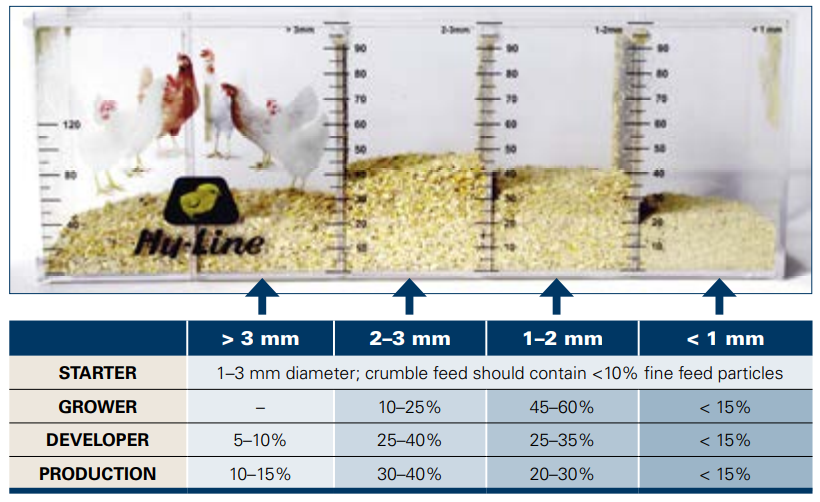
Selective eating by birds
Mash (meal) feed is generally a mixture of coarse and fine particles. Birds preferentially consume larger feed particles. These large particles are frequently coarse-ground corn, which is an important source of gross energy. Fine feed particles usually contain the synthetic amino acids, phosphorus, vitamins and trace minerals. The vitamin/mineral premix is usually fine particle. Birds that overconsume larger feed particles generally have high energy intake and low intake of other important nutrients, such as Vitamin A, vitamin D, riboflavin, sodium, lysine and methionine. Many egg production and shell quality problems are due to inconsistent nutrient intake caused by selective eating.
Birds that are fed too often or in excessive amount are not encouraged to eat the fine feed particles. Fine particle feed can accumulate in the feeders if not properly managed. Encourage the consumption of fine feed particles by leaving a gap of 2–4 hours mid-day. This allows birds to clean the feeders and consume fine particles during this time. Farmers should monitor the feed bins and feeders to assess feed disappearance to determine the appropriate feeding frequency and feed depth that optimizes the daily consumption of both large and small feed particles.
It is important that birds consume both large and fine feed particles on a daily basis to ensure a balanced nutrient intake.
Granulometry (determining feed particle size)
The standard method for determining particle size is The American Society of Agricultural Engineers (ASAE) procedure S319.1. (http://animalscience.unl.edu/ Research/RumNut/RumNutLab/21-ParticleSizeAnalysis.pdf). The procedure involves passing feed or ingredients through a series of 14 screens (sieves) of progressively smaller diameter for 10 minutes. The results are reported as Geometric Mean Diameter (GMD) and a measure of particle size uniformity (standard deviation or coefficient of variation [CV]). Properly manufactured feed should have a CV of less than 10%. This procedure is normally only done by large feed mills.
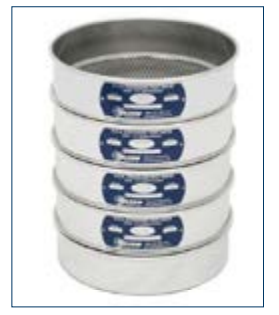
For evaluation of feed particle size on the farm Hy-Line has its own hand-held sieve shaker that can determine particle distribution of mash feeds (Figure 1). This is a useful tool for farmers to check feed deliveries from the feed mill and check particle size in the birds' feeder.
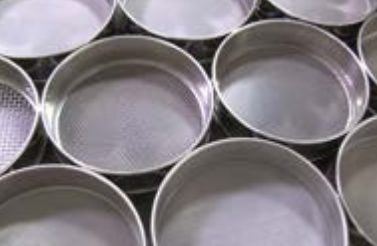
The effect of milling process on feed particle size
Raw material particles undergo multiple changes through the feed milling process. The biggest factor affecting particle size is how the diet is milled. Raw materials, such as soybean meal, fishmeal and premixes, are usually in a form that do not require further particle size reduction. Cereal components (i.e. corn, wheat and other whole grains) of diets always undergo a grinding process. Different ingredient types will behave differently when ground. For instance, wheat will produce a different particle size than corn run through the same grinder.
Hammer and roller milling are two of the most common methods used to grind raw materials.
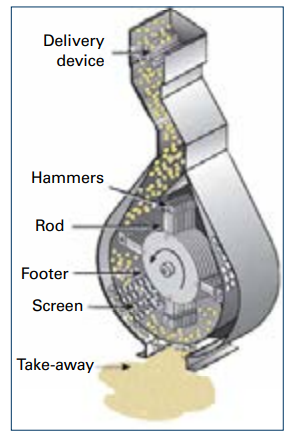
Hammer mills (Figure 4) are comprised of rotating sets of hammers that use impact force to break down the grain. The hammers rotate at high velocity and break down the material until it can pass through the surrounding screen. Particle size and uniformity produced by a hammer mill depends on the size, shape, speed and wear of the hammers, as well as the type and diameter of the screen used. Hammer mills are able to produce a wide range of particle sizes. They work well with fiberous materials like wheat by-products.
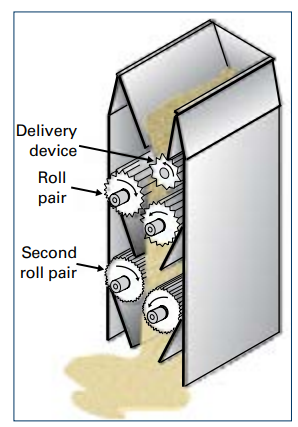
Roller mills (Figure 5) utilize cylindrical rollers, usually in pairs, to compress and sheer (tear) grains into smaller particles. Feed passes through a series of 2–6 roller pairs which have corrugations or grooves cut into the surface. One roller typically rotates faster and in the opposite direction to create sheering force. Particle size is determined by the number of rollers, distance between rollers, roller diameter, speed and corrugation pattern. Generally, roller mills grind grain into more uniformly sized particles than hammer mills (Figure 6).
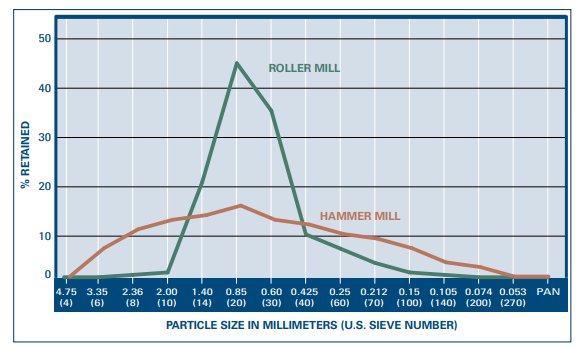
Feed delivery systems
There are three methods of delivering feed in automated feeding systems.
Chain type feeders (Figure 7) - feed is distributed by dragging feed around the feed system with a chain. Chain feeders can cause feed particles to separate by size as it moves feed. The chains can grind the feed particles while being conveyed through the system, although new chain type systems minimize this effect. Slow-moving chain feeders might be problematic as birds at the beginning of a feed line can select out the larger feed particles.
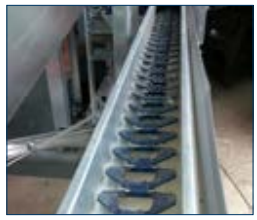
Auger type feeders (Figure 8) - an auger is used to distribute the feed. The auger moves feed more rapidly with less feed particle separation and grinding than with chain feeders. Auger feeders typically deliver less feed volume than chain feeders with each feeding.
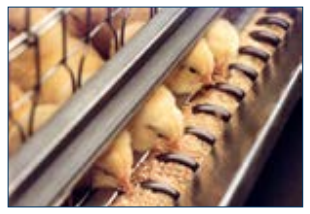
Hopper type feeders (Figure 9) - a traveling hopper distributes feed by moving down the feed line, dropping feed by gravity. This system causes minimal separation and grinding of feed particles compared to other types of feeders.
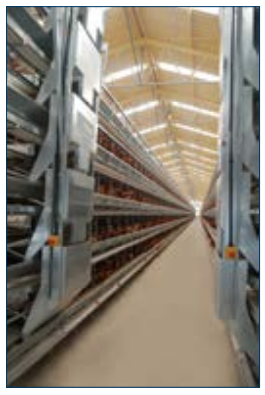
Management of the feeders is important to minimize the negative effects of feed particle separation and prevent the accumulation of fine feed particles. Frequent feedings of smaller quantities minimizes the accumulation of fine feed. Chain feeders generally deliver a larger volume of feed, making the accumulation of fine particles possible. Allowing the birds to clean the feeders daily will prevent the accumulation of fine particles. Ensuring that there is enough feeder space for all birds to eat at one time will create more uniform nutrient intake in the flock. Each system has potential feed particle segregation issues that must be monitored by farm managers. Drag chain systems have more side-to-side segregation, where the fine particles are concentrated in the middle of the trough, but the larger particles congregate near the trough walls. In auger systems, there is more top-tobottom segregation, with fine particles settling at the bottom of the trough and the larger particles remaining near the feed surface. Repeated cycling of the auger can reduce this separation.
Troubleshooting
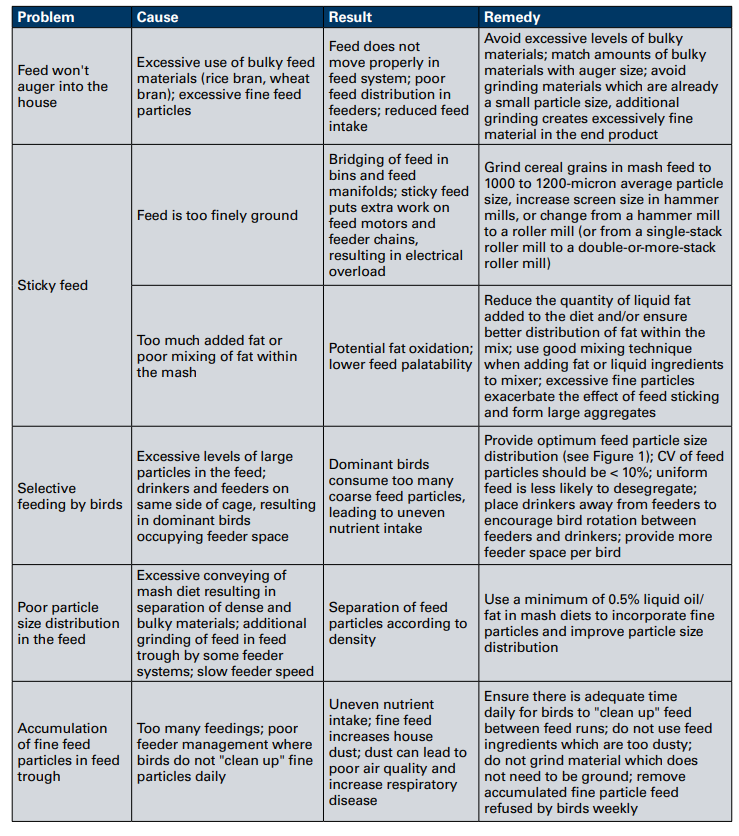
Subscribe top the Hy-Line International technical newsletter










